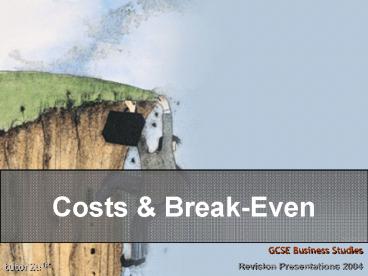Costs - PowerPoint PPT Presentation
1 / 13
Title: Costs
1
Costs Break-Even
GCSE Business Studies
tutor2u
Revision Presentations 2004
2
Introduction
- A business has many different costs, from paying
for raw materials through to paying the rent or
the heating bill - By careful classification of these costs a
business can analyse its performance and make
better-informed decisions. - The main ways in which a business needs to manage
its costs are as follows - Classification of costs into fixed and variable,
direct and indirect - Variance analysis to see if the business is
keeping control of its costs - Break even analysis which tells a business what
it needs to sell to cover its costs
3
Variable and Fixed Costs
- Variable costs
- Change in proportion to amount of output
produced E.g. - Raw materials
- Workers wages
- Energy/fuel for machines
- Fixed costs
- Remain same, no matter how much business
produces. E.g. - Rent
- Salaries of head office workers
- Heating and lighting
- Insurance
4
Semi-Fixed Costs
- Costs which are normally fixed, but change (i.e.
become variable) as the business reaches stages
of growth - Costs which only change when there is a large
change in output - For example, costs associated with buying a new
machine to cope with increased production
5
Standard Cost
- A way of estimating what the likely cost of
something is going to be - Cost per unit of production when product is made
with - Correct quantity and quality of materials, and
- In exact time allowed for its production
- Standard costs are often used in the preparation
of the annual production / cash flow budget - Estimate what raw material and production labour
costs will be based on the expected level of
output - Can then compare actual costs against standard
6
Variances
- When ACTUAL cost is either greater or less than
standard cost - Where actual costs are more than standard
adverse variance - Where actual costs are less than standard
positive variance
7
Using Standard Costing to Manage a Business
- A variance (difference) from standard may
indicate what course of action to take to correct
something which is going wrong - A greater cost than standard (adverse variance)
might lead to an investigation into how inputs
were being used - E.g. too much waste of raw materials, incorrect
operation of machinery
8
Opportunity Cost
- Financial benefit forgone of next best
alternative use of money - A business can measure outcome of a decision by
comparing it with benefits (profits or revenue)
it could have had if it had taken next best
option - Opportunity cost of buying a new piece of
machinery might be compared with spending money
instead on a new advertising campaign
9
Direct and Indirect Costs
- Direct costs
- Costs which can be identified directly with
production of a good or service - E.g. raw materials
- Indirect costs
- Costs which cannot be matched against each
product because they need to be paid whether or
not production of good or services takes place - E.g. rent on premises
10
Break-even Point
- Point at which contribution from number of units
sold exactly equals all fixed costs of business - Profit is made above break even point when number
of units sold exceeds number of units at break
even point - Contribution
- Amount of money each unit sold contributes to pay
for fixed and indirect costs of business. - Contribution selling price less variable cost
per unit - E.g. a product sells for 15 and has variable
costs per unit of 11. Each unit sale therefore
makes a contribution of 4 towards fixed costs of
business. If business had fixed costs of
20,000, then it would need to sell 5,000 units
(4 x 5,000 20,000 contribution) in order to
break even
11
Break Even Chart - Example
12
Importance of the Break-even Point
- Contribution from every unit sold above breakeven
point adds to profit - Breakeven point provides a focus for business
- Also helps it work out whether forecast sales
will be enough to produce a profit and whether
further investment in product is worthwhile. - How calculated
- Number of units needed to break even is
calculated by - FIXED COSTS
- SELLING PRICE - VARIABLE COSTS
13
Limitations of Break-even Charts
- Do not take into account possible changes in
costs over time period - Do not allow for changes in selling price
- Analysis only as good as quality of information
- Do not allow for changes in market conditions in
time period e.g. entry of new competitor































